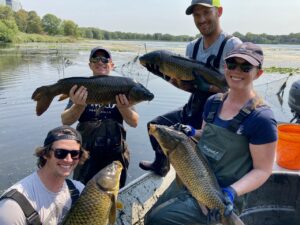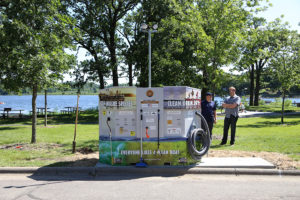Prevent Aquatic Invasive Species
Summer is great for recreation…and stopping the spread of aquatic invasive species (AIS)
AIS or aquatic invasive species are fish, plants, or insects living in the water that come from another part of the world. This includes organisms such as zebra mussels, common carp, curly leaf pondweed, and Eurasian watermilfoil. AIS can take over and make the conditions less than ideal for native species of aquatic plants, animals, and other organisms. For example, common carp will dig around at the bottom of lakes looking for food, which stirs up the water and causes poor living conditions for other fish. The stirred-up mud also blocks light from reaching the plants other fish need to hide from predators.

Clean, Drain, Dry and Dispose
During the summer months there are lots of lake activities to choose from: fishing, swimming, kayaking, paddle boarding, and many more. Moving boats and fishing gear between waterbodies creates an ideal scenario for AIS transportation; they can easily catch a ride to invade the next body of water. Obviously this is not ideal for our native species because AIS are often able to survive through more harsh environments than native species. Remember these four words when recreating on the water this summer: Clean, Drain, Dry, Dispose!
Clean off your equipment after leaving the water.
Drain your watercraft of any excess water. AIS often hide in water left in motors, live wells, bilge areas, and bait buckets.
Dry off watercraft and equipment before entering a different body of water. Some AIS (like zebra mussels) can live outside of water for a week or more!
Dispose of any plants or creatures you find attached to your watercraft or equipment. AIS love to hitch a ride to other water bodies, and often attach to very hard to reach places.

How can you help?
- Make use of boat cleaning stations if your lake has them, like the CD3 station at Bryant Lake in the above picture.
- Dispose of unused bait in the trash instead of the body of water you are fishing on.
- Don’t dump unwanted aquarium fish and plants into a lake; instead, look for rehoming events through your local pet store or the MN Aquarium Society.
- Tell your friends about the steps to prevent the spread of aquatic invasive species!
- Sign up for this AIS Workshop on June 27th from 6:30-8:30 PM held by the Bush Lake Chapter-Izaak Walton League of America: www.bushlakeikes.org/event-5285353
Learn more at our AIS page: Aquatic Invasive Species
